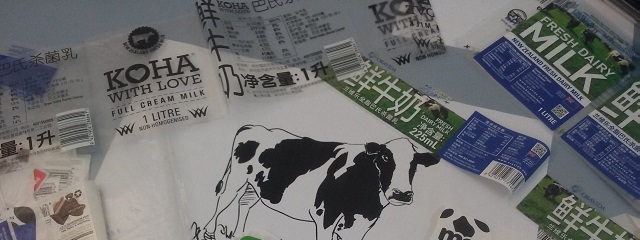Cow to cafe in 24 hours
So much language, literacy and numeracy in these labels. Product lines, different overseas export markets, all produced with slightly different ingredients, fat and protein levels, organic certification or not etc. The product’s story is how milk gets from a cow wandering around the fields of the Bombay Hills to a flat white served up in Beijing 24 hours later – a story involving milking, mixing, bottling, labelling, transporting to the airport and away…. and that’s just the first half of the distribution story.
Communication skills work at the dairy factory
We’ve just finished a course with operators working in a dairy factory. Part of the course was about helping employees to see the big picture – how the bottling process they work on fits in with all the other operations happening in the dairy. There was also quite a lot of focus on the details – understanding the technical English in the SOP for a bottling machine; working out the implications of a particular procedure and what that actually means in practice. Verbal communication skills are key – making yourself heard above the noise of machinery, spotting a problem early and preventing serious wastage, contamination or an accident; understanding and checking instructions so you are clear about the job you’re supposed to be doing. Numeracy for some was a focus too – working with volumes, measurements and weights and the English words used to report and document them.
Building communication skills, belonging and staff retention
The other key area in the course was on developing the culture of multi-cultural teams and so much of this is about communication. The staff come from a wide range of backgrounds. Many are recent migrants but lots have lived in New Zealand all their lives. Communication skills are critical in terms of building a sense of belonging and team spirit in this group, helping people build their skills and building the confidence of individuals at work. As well as the more “formal” learning, the group shared a lot of food and food brings people together. Yes, some people leave after training but if you’ve gone to the trouble of employing people, you want to do everything you can to retain them. Breaking down the mysteries of workplace communication and building teams is a great starting place.
Links
Workplace Literacy Fund. Most of the learners on the course were funded and this paid for our services and the programme development. It’s an incredibly flexible fund and can be use to deliver tailored courses to meet the learning and development needs of an individual business, as long as the main focus is on building communication skills (English language, literacy or numeracy) and the learners are eligible.
Employer guide for employers recruiting migrant workers for dairy farms. There’s a good chapter on communication. The guide emphasises how language builds social cohesion. A great starting point.
From the Skills Highway website, here’s a template to start planning the outcomes you want from a programme.
And FYI, here’s a example of an SOP for making cheddar cheese. It’s extremely complex in terms of vocabulary level: Words like “coagulant”, “rennet functions”, “curd” and “enzymatic reactions” are technical words. They have technical meanings and are quite hard to pronounce! On the course, we took similar SOPs and learners reworked them to make them much easier to follow.
